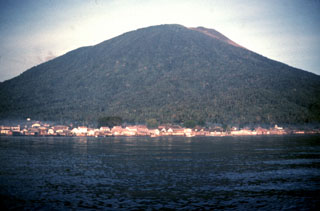Report on Gamalama (Indonesia) — September 1980
Scientific Event Alert Network Bulletin, vol. 5, no. 9 (September 1980)
Managing Editor: David Squires.
Gamalama (Indonesia) Explosions from two craters; evacuees return
Please cite this report as:
Global Volcanism Program, 1980. Report on Gamalama (Indonesia) (Squires, D., ed.). Scientific Event Alert Network Bulletin, 5:9. Smithsonian Institution. https://doi.org/10.5479/si.GVP.SEAN198009-268060
Gamalama
Indonesia
0.81°N, 127.3322°E; summit elev. 1714 m
All times are local (unless otherwise noted)
The eruption continued vigorously into late September. Seven explosions were recorded during the first week of activity, 17 the second week, and 15 the third week. Eruption clouds ranged from about 500 m to 1,800 m in height. Bombs fell as much as 1 km away, most heavily to the N and NE. By early October, eruptions had ended, but seismicity continued, with episodes of volcanic tremor lasting up to 4.5 hours. Most evacuees had returned home, but some small villages in the NE sector red zone remained evacuated.
Kompas newspaper reported that a new crater had formed ENE of the summit. Both the summit crater (two vents) and the new crater have ejected incandescent tephra.
Geological Summary. Gamalama is a near-conical stratovolcano that comprises the entire island of Ternate off the western coast of Halmahera, and is one of Indonesia's most active volcanoes. The island was a major regional center in the Portuguese and Dutch spice trade for several centuries, which contributed to the extensive documentation of activity. Three cones, progressively younger to the north, form the summit. Several maars and vents define a rift zone, parallel to the Halmahera island arc, that cuts the volcano; the S-flank Ngade maar formed after about 14,500–13,000 cal. BP (Faral et al., 2022). Eruptions, recorded frequently since the 16th century, typically originated from the summit craters, although flank eruptions have occurred in 1763, 1770, 1775, and 1962-63.
Information Contacts: A. Sudradjat and L. Pardyanto, VSI; M. Krafft, Cernay; Kompas, Bandung.

